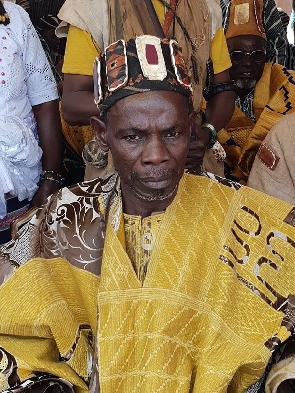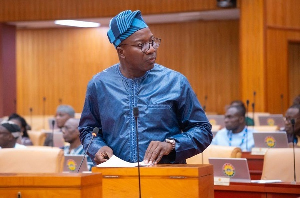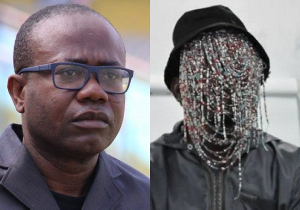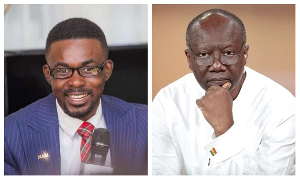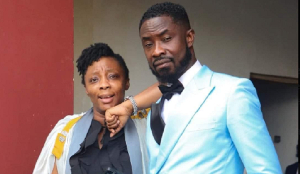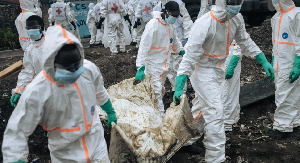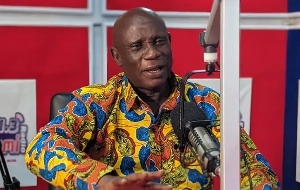I have been inundated with calls and messages by many media professionals, prominent people, friends (especially those who not Gonjas) on who is the successor to the late King and Overlord of the Gonja Kingdom.
I felt reluctant to talk on the issue but this feature will give more insight on this issue.
The Acting Head of State of the Gonja Kingdom Sonyowura Adamu Kanyiti, the Regent of the late Yagbonwura and other traditional stakeholders have set 26th February, 2023 as the date for the seventh day funeral rites of the late Yagbonwura Tuntumba Boresa (I) who passed on, on Sunday 5th February, 2023. The announcement was made during the third day funeral rites of the late Yagbonwura held at the Jakpa Palace in Damongo on February 10, 2023.
Going by all customary and traditional laws that have been preserved by the Gonja Kingdom for over 400 years as well as modern laws, the election and selection of a successor to a deceased Yagbonwura is done a day after the performance of the seventh day funeral rites of the late Yagbonwura in the morning at the Yagbonwura’s Palace and the twelfth (12th) day funeral rites of the late Yagbonwura is performed by the Yagbonwura-elect.
It is becomimg clear that the Paramount Chief of the Tuluwe Traditional Area of the Gonja Kingdom, Tuluwewura Soale Mbema Borenyi who was enskined as Tuluwewura on 21st April, 2020 is likely to be enkined as the next King and Overlord of the Gonja Kingdom after the 7th Day funeral of the late Yagbonwura Tuntumba Boresa (I). This is in accordance to the succession arrangement of Gonja Kingdom for hundreds of years.
Even though the Tuluwewura is the “next Yagbonwura”, the Customary, traditional and modern laws of Gonja are expected to be strictly followed.
The Tuluwe Skin of Gonja is one of the five divisional skins that ascends the Gonja throne. The Paramount Chiefs of Gonja that are currently qualified to ascend the Gonja throne in terms of seniority are Wasipewura, Kpembewura, Bolewura, Tuluwewura and Kusawguwura.
The next likely King of Gonja, Tuluwewura Soale Mbema Borenyi was first enskinned as Jakpaseri-wura from where he moved to the Timanklan-wura skin to Kachinako-wura and finally got to the Bunda skin in 2011. (The Bunda skin is the entry gate to Tuluwe Skin).
The Traditional organisation of the Gonja Kingdom has been touted as one of the best in the Northern part of Ghana. The Founder of the Gonja Kingdom Sumaila Ndewura Jakpa established a state with well developed institutions and structures that marveled even the white colonialists on arrival in Gonja.
Currently there is a Constitution (Inquiry Into the Constitution of the Gbanya ‘Gonja’ Kingdom- 1930) which stipulates a healthy succession at all levels especially at the Yagbon level.
The last time there was a major succession crises in the Gonja Kingdom that partly disintegrated the Kingdom and truncated the succession arrangement of the Yagbon throne for many years started in 1895 and ended in 1912. This was after the death of Yagbonwura Kurbang (Seidu Dushi) from Bole in 1895.
Indeed the Gonja system at the Yagbon level since 1912 has been insulated from problems of succession with its concomitant problems thanks to the foresight, vision and good leadership of the founder of the Gonja Kingdom, Sumaila Ndewura Jakpa and his progeny. The legendary Ndewura Jakpa established a democracy and a very peaceful succession plan that is so marvelous. So there is the remote possibility of a succession crises at the Yagbon level in Gonja which is the biggest Kingdom (in terms of landmass) in Ghana.
It is true British colonial decisions have added to what has been bequeathed to Gonjas by their forefathers centuries ago.
The 1930 Constitution of the Gonja Kingdom has been able to withstood the test of time since it was adopted.
A great and valorous ruler whose vision and good leadership sustained and cemented this peaceful succession at the Yagbon level is Yagbonwura Mahama Dangbonga from Bole who ruled from 1912 to 1937.
Yagbonwura Mahama is now referred to as the 'Contemporary Founder' of the Gonja Kingdom.
After Sumaila Ndewura Jakpa structured the Kingdom devoid of problems, Gonja along the line failed Jakpa by extensively practicing self- Paramountcy rule.
But in the early 19th century, Yagbonwura Mahama Dagbonga began the Gonja reunion process and achieved the objective in 1930 thereby restoring the reunion of Gonja from an acephalous system of Chieftaincy mechanism to a centralized system.
It was during the reign of Yagbonwura Mahama Dagbonga that Gonja came out of a confederacy into nationhood.
Two conferences were held in Yapei in 1923 and 1930, under the auspices of the British colonial administration. It was the 1930 meeting that was successful and which gathered momentum and gave Gonja its modern constitution entitled 'Enquiry into the Constitution and organisation of the Gbanye (Gonja) Kingdom'. This document has guided succession in modern times and has withstood the test of time.
At the conference the constitution of the Gonja Kingdom was codified and the relative seniority of the Chiefs and the extent of their powers were drawn.
Also, an agreement on the list of chiefs qualified to mount the paramouncy was reached. The conference established a strict system of rotation which has helped Gonja through peaceful successions especially at the Yagbon level.
On the issue of succession at the Yagbon Kingship of Gonja, there are traditional, customary and legal procedures to follow on the death of a King and Overlord (Yagbonwura) of the Gonja Kingdom and the subsequently enskinment of new King.
The Chief of Sonyo (Sonyowura) plays the most important and crucial role with regards to the transition and succession of a Yagbonwura.
The Sonyowura, according to Gonja custom and Tradition, becomes the Acting Head of State on the death of a Yagbonwura and he administers the affairs of the Gonja Kingdom until a new Yagbonwura is selected. The Sonyowura is also responsible for most of the traditional, customary and legal procedures to follow on the death of a Yagbonwura.
The exceptions are that the Sonyowura can never ascend the Yagbon skin and he cannot give a title to any Chief for a higher Chieftaincy position like a Paramount Chief in the absence of a Yagbonwura. The Sonyowura’s reign as Acting Head of State ends the very moment a new Yagbonwura is enskined and quickly retires to his Sonyo Community.
On the death of a Yagbonwura, the Sonyowura firstly informs the Nlusah (diviners) of Mankuma a community near Bole because they must perform certain secret customary rites, before the funeral of the deceased Yagbonwura is formally announced.
After that the Sonyonwura sends the deceased Yagbonwura’s horse, unsaddled, together with his staff and sandals to the Buipewura to announce the death of the King.
On the receipt of the formal notification, the Buipewura will inform the Kagbapewura of Buipe of the Yagbonwura’s death and then the processes for burial and enskinment of a new Yagbonwura begins.
In modern times, Ghana’s Parliament approved customary laws on the line of succession of 11 traditional areas including the Gonja Traditional Area in 2010. The codification of the customary laws on succession provides the needed guiding principles to deal with chieftaincy of the Traditional Areas concerned.
The key provisions of the instruments include succession and system of inheritance, election or selection of candidates to stools and skins, Kingmakers, destoolment or de-enskinment and autonomy of stools and skins in accordance with section 51 of the Chieftaincy Act 2008 (Act 759).
A legislative instrument (Declaration of Customary Law (Gonja) Traditional Council Instrument, 2010) gave effect to the recommendations of the Gonja Traditional Council on the 23rd day of March, 2010.
This document is the alpha and omega on the succession, election or selection of a candidate to the Yagbon Skin on the demise of a Yagbonwura.
The Declaration of Customary law states; “Succession to the Yagbon Skin of the Gonja Traditional Area shall be by the patrilineal system of inheritance.
It further states; “Succession to the Yagbon Skin of the Gonja Traditional Area shall be strictly⁶ rotatory among the Chiefs of the five gates of the Gonja state”, that is, “Wasipewura, Kpembewura, Bolewura, Tuluwewura and Kusawguwura” in order of seniority.
Notwithstanding this strict rotation system, a Paramount Chief occupying a gate to Yagbon throne could be disqualified based on some factors and in the event of a disqualification the skin moves to the next gate. In Gonja ailments like stroke, blindness, amputation of an arm or leg to the big toe or big finger are automatic disqualification reasons. When a Chief in such a situation is already occupying a title other than a higher title, it serves as a terminal limit for him even when he is due for promotion or elevation.
There have been instances in the Gonja Kingdom in which the strict rotation to the Yagbon throne could not be followed mostly for reasons of sickness by those succeeding.
In recent times after the demise of Yagbonwura Bawa Abudu Doshie in 2010, the fourth gate (Tuluwe) was to take over unfortunately the then Tuluwewura Afin Nnase could not ascend the throne because he was indisposed so it moved to the occupant of the fifth gate, the Kusawguwura who enthroned as Yagbonwura Sulemana Jakpa Tuntumba Boresa (I) but with the understanding backed by documentation that it goes back to Tuluwe should Tuluwe be occupied by a Chief that is qualified when the Yagbon Skin becomes vacant.
So all things being equall, Tuluwewura Soale Mbema Borenyi who is fit is the “next Yagbonwura” even though the Customary Law is expected to be strictly followed.
The Tuluwera will end the cycle of five gates that ascends the Gonja throne after which the first gate Wasipe (Daboya) begins another cycle.
According to the Declaration of Customary Law (Gonja Traditional Council Instrument, 2010), the Sonyowura shall nominate a new occupant to the Yagbon Skin and present him to the other Kingmakers for their approval. The Kingmakers of the Yagbon Skin of the Gonja Traditional Area shall be the Sonyowura (Head of the Kingmakers), Damongowura, Choriwura, Debrewura, Mankpangwura, Kulawwura, Kpansheguwura, Nsuawura, and Busunuwura.
The Declaration of Customary Law further states that; “Nomination by the Sonyowura and approval by the other Kingmakers shall be done after the third day funeral rites but before the seventh day funeral rites of the deceased Yagbonwura and that “after the performance of the seventh day funeral rites of the deceased Yagbonwura, the Sonyowura together with the other Kingmakers shall meet at the Traditional Council Office at Damongo where they shall make known to Chiefs of the five gates their choice for succession to the Yagbon Skin for their comments”.
The Declaration of Customary Law further says; “The election and selection of a successor to a deceased Yagbonwura shall be done a day after the performance of the seventh day funeral rites of the late Yagbonwura in the morning at the Yagbonwura’s Palace” and that “The twelfth (12th) day funeral rites performance of the late Yagbonwura shall be performed by the Yagbonwura-elect as custom demands.
On the installation of a new Yagbonwura the Customary Law states that; “The Chief-elect shall be enskinned on a day suitable to him after the performance of the twelfth day funeral rites of the late Yagbonwura and the enskinment shall be by the Kagbapewura at Nyange. The Kagbapewura shall first be informed of the date by the Sonyowura through the Buipewura”.
The Declaration of Customary Law further made it clear that; “The Yagbonwura’s enskinment shall be said to be consummated when the new Yagbonwura has been kept in confinement as tradition demands for a number of days depending on the new Yagbonwura’s wish”.
Opinions of Friday, 17 February 2023
Columnist: nkilgifmonline.com





